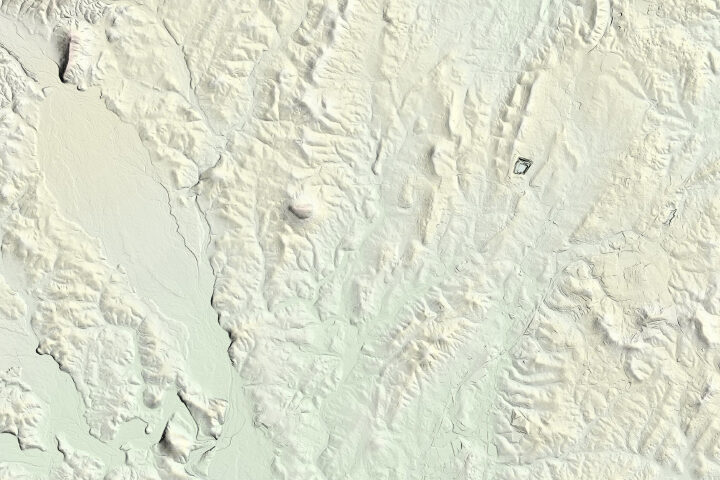
Every month on Earth Matters, we offer a puzzling satellite image. The October 2019 puzzler is above. Your challenge is to use the comments section to tell us what we are looking at, where it is, and why it is interesting.
How to answer. You can use a few words or several paragraphs. You might simply tell us the location. Or you can dig deeper and explain what satellite and instrument produced the image, what spectral bands were used to create it, or what is compelling about some obscure feature in the image. If you think something is interesting or noteworthy, tell us about it.
The prize. We can’t offer prize money or a trip to Mars, but we can promise you credit and glory. Well, maybe just credit. Roughly one week after a puzzler image appears on this blog, we will post an annotated and captioned version as our Image of the Day. After we post the answer, we will acknowledge the first person to correctly identify the image at the bottom of this blog post. We also may recognize readers who offer the most interesting tidbits of information about the geological, meteorological, or human processes that have shaped the landscape. Please include your preferred name or alias with your comment. If you work for or attend an institution that you would like to recognize, please mention that as well.
Recent winners. If you’ve won the puzzler in the past few months or if you work in geospatial imaging, please hold your answer for at least a day to give less experienced readers a chance.
Releasing Comments. Savvy readers have solved some puzzlers after a few minutes. To give more people a chance, we may wait 24 to 48 hours before posting comments.
Good luck!
See our Virginia’s Volcanic Past Image of the Day for the answer.





Ice sheet and snow over continent in Antartica. It is interesting because it shows a mountain peak and lake on the continent. It shows some of the landscape of Antartica.
Jupiter surface
A glacier mountain range starting to melt ?
Devil’s Tower
I could be, way off here but it really just came to mind when I seen the photo.
I believe it to be White Sands New Mexico, United States. It is the northern end of the Chihuahua desert.
The sands are formed from gypsum, a soft mineral that is left behind when salt water bodies of water evaporate. Although common, gypsum is rarely found as sand because it dissolves in water and usually carried to sea. As there was no outlet to the sea in the dried desert of NM the waters evaporated and these tiny crystals were broken down into tiny grains over 70 million years ago when the sea dried out. About 6-7,000 years ago the gypsum began to form dunes. Which is one of only two places on earth that you can find pure gypsum dunes which are nationally protected.
Shot with the ALI on NASAs EO-1?
Could be way off, but ??♀️
info: nasa.gov
A polar icecap. It’s interesting (and disappointing) because you can see the brown of the ground peeking through in some places — through the ice it looks a bit yellow.
Giant asteroid a space rock
A glacier in Canada.
Amazonas??
Greenland
I think it looks like the top of a water recycling facility with some of the crud filtered out on top. Could be anywhere.
I think it looks like the top of a water recycling facility with some of the crud filtered out on top. Could be anywhere.
Salt or mineral flats? Sand? Definitely not Greenland or Antarctica. There appears to be a mine or pit or some other man made feature, in upper right quadrant.
I think this is the terrain map of Virginia? Mole hill?
I see evidence of an ancient society. There are buildings, farming, infrastructure and what looks like a pyramid with steps (possible temple.) It appears that whatever society that lived here was suddenly buried by a natural catastrophe. Perhaps a volcanic eruption, though I don’t know where the location is.
Looks like a lidar image with all the vegetation removed to show underlying geologic structure. May be in Pennsylvania?
The terrain appears to be extraordinarily arid. Lidar photo of a desert region. There is a mine pit, roughly rectangular on the Plunging slope of an eroded anticline. There appears to be a railroad or roadcut on the right side of the image. I perceive shadows on steep slopes, namely the tall promontory in the middle of the image, as well as canyon walls that abut the large outwash plain.The erosional surfaces on two of the outwash plains show a distinct change to a lower elevation, note the shadowing of scarp in the outwash plain to the left of the promontory, as well as the shadowing that occurs in the slopes of the mountains in the lower left hand side of the picture. Location ?, I do not know.